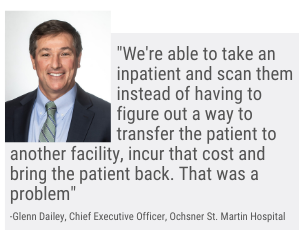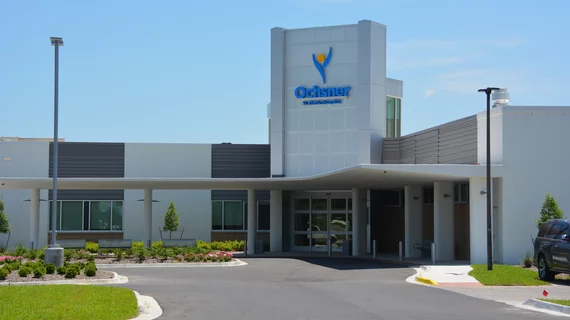As a rural, critical access hospital, Ochsner St. Martin Hospital in Breaux Bridge, La., prides itself on restoring, maintaining and improving the health of their community, which sits between Lafayette and Baton Rouge. But a few years ago, the 25-bed hospital—that services the “Crawfish Capital of the World”—realized they weren’t living up to that mission as they turned away patients seeking open MRI services because they only offered closed system options.
Among the types of patients they couldn’t scan were those with known claustrophobia, which can be up to 15% of the population, or even those with a circumstance-specific fear of being confined in an MRI bore. The same was true for patients with large body habitus, a population that was significant in their area. In all cases, they were directing patients to a facility outside of the Ochsner Health system with open MRI capabilities. Never a good plan.
“We probably had seven MRIs within this area, but none were open,” said Glenn Dailey, Ochsner St. Martin’s chief executive officer.
So the hospital set out to make a change.
A choice: Get a larger closed MRI, or make the jump to open
Dailey, a former nuclear medicine technologist, appreciated the need to expand their offerings. So did the purchasing committee of radiologists, MRI techs, and the hospital’s imaging manager. The committee knew that their current MRI setup, which consisted of an older but mobile, closed bore system, wasn’t working. But they also weren’t fully committed to the idea of moving to open MRI. Initially, they wondered if they could opt for a large-capacity closed model instead.
Ultimately, the team decided that an open model was not only key to addressing an unmet need, but also made business sense. “Given that we had [a large-capacity open model] down the road, we felt like the biggest opportunity to capture more of the market would be to go ahead and go with the open,” Dailey says. “We're [also] trying to open up to where we can do bariatric surgery here as well, so that goes hand-in-hand with our ability to image some of the bariatric patients.”
 Overcoming image quality concerns
Overcoming image quality concerns
In spite of the clear business case and community need, the committee wanted to make sure that they were prioritizing image quality, not just capturing potential market share. At first, some radiologists had doubts about open MRI due to preconceived notions about sub-par image quality.
“Some of them wanted a closed system, just because they felt like the image quality was going to be sacrificed with an open,” he notes.
Not so at all, Dailey says. He was able to make a firsthand case for the image quality of the Fujifilm Oasis 1.2T, an open MRI scanner used at Ochsner Acadia General Hospital, where he previously worked. He was involved in the late stages of purchasing that system, and before the selection was made, he was able to compare images from the Fujifilm scanner side by side with those of competitors.
“Being a technologist…I understand what the final outcome needs to be,” he says. “And so when you can see two sets of images side by side, and you are looking at close to the same pricing, but you get so much more out of the Fuji image than the competitor, it's a no brainer. Image quality is everything in radiology.”
The Ochsner St. Martin purchasing team was “very, very impressed” too—and some of them a bit surprised, even—to see that together with “amazing” software, the 1.2T magnet produced images that far surpassed their expectations.
Open MRI was the right choice, according to their radiologists.
“All of the radiologists have noticed a dramatic improvement in the quality of MR studies since the magnet upgrade at OSMH went operational,” says Justin Owens, MD, a radiologist with Regional Radiology Group, “as well as overall improvement in patient satisfaction with the ability provide ‘open-MRI’ capabilities.”
Local support cuts down on downtime
The time from decision to installation took approximately three years because the facility was undergoing an expansion project that doubled its size.
The go-live was far quicker. “It took [the service team] about three weeks to get the system up and running,” Dailey says. “We had two weeks of applications, followed by a second set of applications. Fujifilm’s team was close by and holding our hands every step of the way. That is important, especially when you’re reaching out to your physicians.”
Splitting the applications service into two parts allowed the Ochsner St. Martin team to get comfortable using the scanner and discover tweaks that needed to be made within the applications and protocols.
Then the service team doubled back to make the changes.
Most scanner service now is done remotely, with Fujifilm technicians able to login and make fixes from afar. But when remote isn’t an option, there’s someone less than an hour away that can come help—which was an important consideration when making the purchasing decision, Dailey notes.
“If you have to have someone who flies in every time to do service, it just doesn't work,” he says. “We can’t be down for a few days.”
Dailey estimates scanner uptime is about 99%—a big change from their previous system that was up and running less than 90% of the time and was once down for an entire week.
“The 99% uptime really makes a difference,” he says. “When you have a bunch of scheduled patients that you have to cancel because a scanner is down, they're not happy. [Since installing the Oasis], I don't think we have had more than one day where we had to move any patients.”
Doubling volume by attracting patients—and MRI techs
Since completing installation in March 2021, the business case for Oasis has come to fruition, too. Not only do people with claustrophobia or large body habitus seek out exams at Ochsner St. Martin, but they also get calls from other inpatient sites without an open MRI option asking if they can send patients over for a study.
“Now we can advertise that we’re one of the only open-air MRIs in the Ochsner Lafayette General region,” Dailey says. “We’ve doubled our volume. That says it all.”
Also by performing abdominal/pelvic exams and carotid procedures has increased the hospital’s ability to provide a broader spectrum of services.
So in addition to attracting more patients, having an open MRI scanner also helps Ochsner St. Martin keep them. Patient cancellation rates—previously high, since patients with claustrophobia or large body habitus often had to be turned away and the old scanner had significantly more downtime—is down at least 30%, Dailey estimates.
“One of the big keys to [the increase in MRI volume] is that we’re able to take an inpatient and scan them instead of having to figure out a way to transfer the patient to another facility, incur that cost and bring the patient back,” he says. “That was a problem.”
Prior to adding open MRI, the hospital was performing about 30 to 40 scans per month. Today, that number has soared to 85 to 90 scans per month.
There’s also was another benefit Dailey didn’t expect. It’s not just patients who are drawn to choose Ochsner St. Martin’s open MRI; so are MRI techs who enjoy working with the system. That’s a big plus, given how difficult it can be to find techs in the current employment environment.
“We actually had one of our MRI techs come here because we were getting the new machine,” he says. They joined us on that basis. “It's so much easier for the techs to set the patient up and go back to the controls. They don't have to be in and out of the room as often as they had to be before with other scanners. The rest of the procedure can be done via the control room as opposed to being out by the patient.”
A better way to serve the community
Radiologists are thrilled. Administration is thrilled. Techs are thrilled. And, perhaps most importantly, patients are thrilled. Patient satisfaction scores are high: in the 99th percentile for MRI satisfaction and the 99th percentile for likelihood to recommend to others.
Dailey understands why patients are so enthusiastic about getting scanned on open MRI.
“You turn your head and you can see out of both sides of the scanner,” he says. “The room has a big, open window to look out of. It’s a much less stressful experience, much more soothing. It came out really nicely.”
In short, choosing the Fujifilm Oasis has helped Ochsner St. Martin move forward on all four aspects of the Quadruple Aim: improving patient care, boosting community health, improving the patient experience, and bettering life for healthcare workers.
For sure, Dailey is glad his team was open to open MRI. “This is well worth the investment,” he says. “It is a huge step forward, especially for this area. Delivering excellence to the patients, the community, the physicians—that's our goal.”
--
Learn more about the Oasis 1.2T by Fujifilm Healthcare
